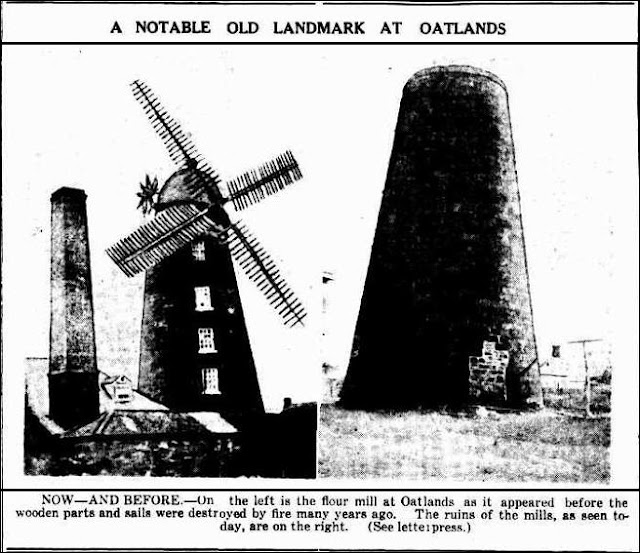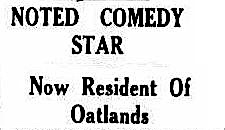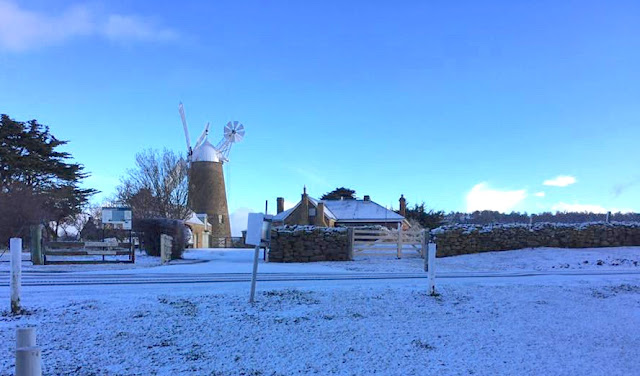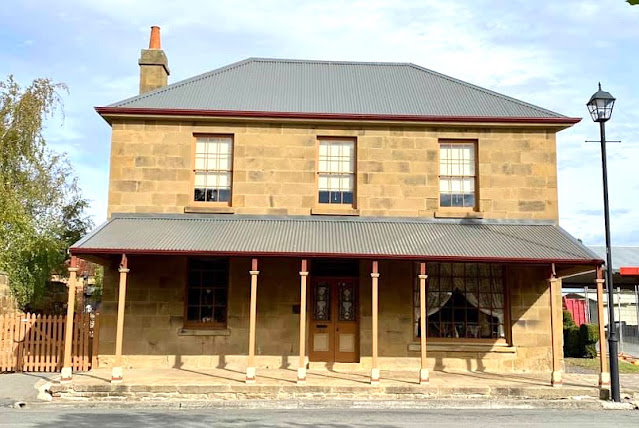The town of Talbot, in Victoria, Australia, can be found 15 km south of Maryborough and 130 km north-west of Melbourne.
Located in the heart of the Goldfields region, Talbot has many historical sites and buildings.
The Dja Dja Wurrung People
Living around the Talbot area for thousands of years, the Dja Dja Wurrung People told creation stories centring around Bunjil, the ancestral creator spirit, often depicted as a Wedge-Tailed Eagle.
According to the Dja Dja Wurrung Dreamtime
stories, Bunjil made
the mountains, rivers, flora, fauna, and laws for humans to live by.
Like many other oral
cultures around-the-world, the Dja Dja Wurrung people used the landscape to tell and recall Creation stories, which trace the journeys of ancestral spirits and their laws.
According to the writer Bruce Chatwin, "Aboriginal Creation myths tell of the legendary totemic being who wandered over the continent in the Dreamtime, singing out the name of everything that crossed their path - birds, animals, plants, rocks, waterholes - and so singing the world into existence".
The ancestral spirit was also believed to be part of the landscape, living in rocks, trees, the earth and sometimes, in the wind and rain clouds.
 |
| Two Aboriginal Australian men in traditional clothing and paint for a coroboree, Author / CreatorVictorian Railways, photographer.Date[ca. 1945-ca. 1954] |
The meaning of Dja Dja Wurrung, according to E.S. Parker and his son, Joseph Parker, comes from
djadja the word for "yes" (yes, yes, tongue/speak), which if true, would be unusual as names for language groups in
this region are often based on "no".
Dja Dja Wurrung is classified as one of the Kulin family of languages. In 1878, 700 words were written down by Joseph Parker, who was the son of one of the Assistant Protectors of Aboriginal people. He also learnt the Dja Dja Wurrung language. Robert Hamilton Matthews
recorded some of the Dja Dja Wurrung language, and parts of the grammar in 1904.
Like other Kulin peoples, there are two moieties (totems): Bunjil the eagle and Waa the crow and adherence to a patrilineal system. These moieties would determine an indivuduals behaviour, social relationships and marriage.
Patrilineal descent meant that Dja Dja Wurrung children inherited the totems of their fathers. People belonging to the same totem were not allowed to inter-marry. Marrying within one’s totem (moiety) was traditionally punishable by death.
Dja Dja Wurrung people used bark for making gunyahs (shelters) and coolamons (used for dishes and for digging).
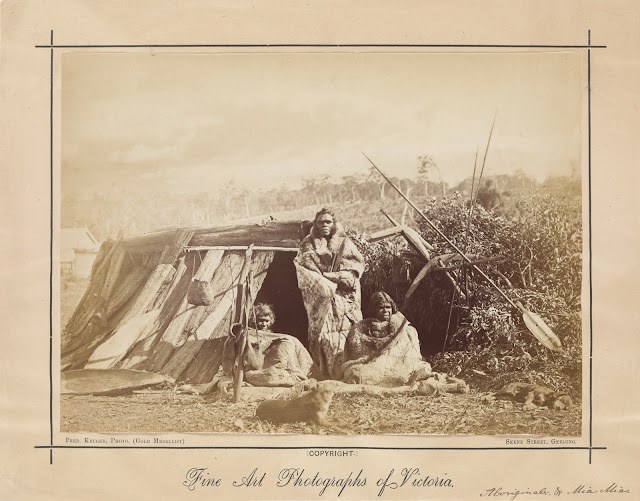 |
| Man, whole-length, wrapped in skins and cloth, standing in front of bark shelter, two women seated on ground next to him also wrapped up, spears and shield propped against branches piled on right. A dog stretched out asleep on right another in middle foreground. Farm buildings visible on left with open land and bush in background. Victorian Aboriginals and mia mia / Fred Kruger. c1880, SLVIC |
Located along Pollocks Road, Talbot is an Aboriginal Shelter Tree, a red river gum (Eucalyptus Camaldulensis) believed to be about 700 years old. The tree has a hollowed-out centre and was used for shelter and by Dja Dja Wurrung women giving birth.
Between Talbot and Maryborough there are four rock wells dug by the Dja Dja Wurrung people.
In 1839, E.S. Parker also noted that yams (murrnong) were the main vegetable eaten by Dja Dja Wurrung in the area. As well as other tubers, bulbs, roots of sedges and rushes, Parker wrote they were "easily extracted by the women with their digging sticks".
The Dja Dja Wurrung men hunted kangaroo, wallaby, emu, possums and birds, and speared fish in the rivers.
 |
| Aboriginal hunting required high levels of expertise and athleticism, the British Library’s catalogue, 1899 |
E. S. Parker, also observed that with European settlement: "The very spots most valuable to the Aborigines for their productiveness - the creeks, watercourses and rivers - are the first to be occupied".
Possum Skin Cloaks (djarun) were worn
in the colder months. Skins would be left to dry, then scraped with rocks or shells; the skins were rubbed with fat then sewn together with the sinew of kangaroo, using a bone needle.
Fire was an important means to manage
the landscape for Dja Dja Wurrung people. However, fire was part of the culture and belief systems too. As fire historian Stephen Pyne wrote:
"Without campfires there would be no storytelling. Without torches and bonfires, there could be no ceremonial community after dark. Without the protective radiance of the hearth fire, Aborigines were defenceless against the evil spirits that marauded the night in search of souls to devour. Fire was ubiquitous in Aboriginal ritual and myth because it was ubiquitous in Aboriginal life".
There is evidence that smallpox, perhaps introduced first from the north by Macassan traders, swept through the Dja Dja Wurrung in 1789 and 1825.
Settlers
The first European settler in the Talbot area (Back Creek) was Alexander McCallum who established "Dunach Forrest" between 1839-41.
In 1839, Donald Cameron also
selected land and named his run "Clunes" after his home in Scotland.
The third expedition of the New South Wales Surveyor-General Major Thomas Livingstone Mitchell in 1836, crossed the Great Dividing Range between Mount Cole and Mount Greenock (close to present-day Talbot).
 |
| Engraving of Major Sir Thomas Mitchell |
Gold Gold had been found in Victoria before
the official date of gold discovery in 1851, which sparked the gold rush. But these finds had been isolated, and those who found gold often kept the knowledge to themselves.
The first gold rush in Victoria was in 1848, when a shepherd named Thomas Chapman found gold at Daisy Hill (later Amherst) on Hall and McNeill's "Glen Mona Run". This find attracted a lot
of attention after the gold was sold in Melbourne at a Collins Street jeweller.
The Argus newspaper reported that fifty men had rushed to Daisy Hill, in hopes of finding gold, in February 1849. But Captain Henry E. Pultney Dana and the native police were stationed in the area to stop any unauthorised occupation of Crown Lands and so stopped the "rush".
 |
Australian Native Police unit in 1870
|
A well-known prospector, Dr Herman Bruhn, found gold near Amherst in 1851. Then in about May 1852, a group of Germans found gold nearby, what would later become Amherst Cemetery, close to Daisy Hill.
Official Discovery
The first official discovery near Talbot was made by two men at Daisy Hill Creek in 1852. One of the men was named Cowley, the other was John Potter. Potter claimed they
found a nugget while trying to free a bogged wagon. This
was known as Cowley’s Rush.
Years later, E. Carton Booth, wrote in his book, Another England: life, living, homes and homemakers in Victoria:
"All sorts and conditions" of men started off for the diggings. It is doubtful whether.' the first expedition was looked upon in a serious light, for the most unlikely persons possible joined in it. Dog-carts, buggies, outside cars and inside cars, any and everything on wheels, or circular contrivances that looked like wheels, were laid under contribution..."
The next major gold find was in early 1854 at Kangaroo Flat along Back
Creek, about two miles southwest of Talbot.
Gold was discovered at Opossum Gully, Amherst, in October 1854. A rush began and the Adelaide Lead was opened.
The Post Office at Back Creek on 24 February 1854.
Goodwoman’s Hill rush commenced in March 1855 behind Dale Goodwoman’s Hotel.
The Chinese arrived in May 1855 and
established camps in Long Gully and Nuggetty Gully.
At the start of 1855 there were approximately 2500 diggers and business owners at Back Creek as well as 300 women and children.
Back Creek and Amherst were to be surveyed in 1855, but many people left for Fiery Creek in September 1855, and this led to the cancellation of Back Creek town survey.
Black Douglas, a well-known bushranger, was caught at Adelaide Lead, on Sunday 5 May 1855.
"One of the stirring incidents of the
early days was the capture of Black
Douglas, the bushranger. He was taken
by the diggers some miles out, and
brought into the town. A big police camp
had been formed in the town for the gold
escort The four-horse coach which car-
ried the gold was flanked with a line of
mounted troopers"."MARYBOROUGH'S JUBILEE." Weekly Times (Melbourne, Vic. : 1869 - 1954) 23 July 1904
 |
| Courier (Hobart, Tas. : 1840 - 1859), Wednesday 23 May 1855 |
In June 1855 there were about 10,000 diggers at Back Creek and Daisy Hill. Riots took place there in June 1855 at Adelaide Lead.
The Town Develops
The Scandinavian Lead, found by prospectors, Carl Hallem, Adolph and Carl Olsen and Joseph Bell, was the richest and most enduring gold discovery in the area. The Scandinavian Lead opened in early 1859 on the site of today's Talbot. Horse-powered haulage whims were used to raise ore or water from the mine. but steam engines took over.
The diggers who rushed to Talbot found areas “alive with gold”. Between 1851 and 1896, the Victorian Mines Department reported that 1,898,391kg of gold was mined in Victoria.
A reservoir built in 1858 by Stewart and Farnsworth on Stony Creek, provided miners with water for sluicing at Back Creek.
In 1859 two new leads adjoining the Scandinavian Lead were discovered: the Rocky Flat and Union leads (opened by a party of Welshmen).
By March 1859 there was an estimated population of 15,000.
"The rush to the Back Creek has assumed gigantic proportions; several thousand are already congregated on the spot, and every hour of the day fresh bodies of miners are pouring in. Stores and other places of business, as well as grog shanties, are being erected by scores, and in short all the signs are there which denote a monster rush".
BACK CREEK, AMHERST. (1859, February 22). Maryborough and Dunolly Advertiser
By the start of March 1859 the developing main street was being called Scandinavian Crescent.
 |
| World's News (Sydney, NSW : 1901 - 1955), Saturday 18 December 1909 |
During the 1850s gold rush, the population of Victoria almost trebled as hopeful diggers flowed into Melbourne, from overseas and other
areas of Australia, then onto the goldfields.
The newspaper, Amherst and Back Creek Advertiser began 5 March 1859. Robert Clark established the Back Creek Register at Talbot in 1859. In the following year, the North Western Chronicle was published. The Talbot Leader dates from 1861.
"Crime is frightfully on the increase in this district, and the hordes of thieves and murderers on the rush are becoming emboldened from the comparative immunity which they enjoy. At present Detective Slattery and a handful of constables are the only men to keep down hundreds of villains of the deepest dye. The report I have forwarded you, of the murderous attack on Mrs Ross, is only one of several crimes ... Several cases of sticking-up have come to our knowledge ... A butcher named Wills was pounced on by four armed men near Sault's Hotel ... A woman was stabbed in the face on Wednesday night ... On Tuesday night a man had his jaw broken ... The feeling among the inhabitants is one of great insecurity. A Court of Petty Sessions will he held daily at Wrigley's Hotel, on and after Monday".
"BACK CREEK, AMHERST." Bendigo Advertiser (Vic. : 1855 - 1918) 17 May 1859
 |
| [Talbot, Vic.] : Theatre Royal, 1859, Saturday November 12, 1859 |
1860s
Name Change
After the Victorian Governor
visited the area of Back Creek in 1861 the name was changed to Talbot, possibly to honour the Talbots of Malahide Castle, Dublin or the Talbots of Shrewsbury, England.
Survey of allotments took place in 1861-62.
"GREAT FIRE AT TALBOT.
£12,000 WORTH OF PROPERTY DESTROYED.
A destructive fire broke out in the Scandi-
navian Crescent, this morning. The cause is
unknown. It lasted two hours and a half, and
destroyed the, undermentioned properties:—
Henderson, bootmaker ; Bowman, bootmaker ;
Ford, fruiterer ; Frazer, hair dresser ; Golden
Cross Hotel ; Samuels, gold assayer ; Theatre
Royal and Hotel; Clarke, stationer; Evans,
tent, maker ; two unoccupied buildings ; the
London Tavern ; Scott, hay and corn store. On
tbe opposite side of the street : — The Municipal
Chambers; London and New York Hotel ;
Rob Roy Hotel ; Harris's school. The total loss
is about £12,000". GREAT FIRE AT TALBOT. (1862, December 5). Mount Alexander Mail
In 1864 there existed a Court House at Talbot, borough offices, seven schools, a street of shops, two breweries, churches, two soap and candle factories, sixteen hotels, coach services and general carriers, and a number of crushers. The population of about 3,400 varied as miners moved about.
The Gold Rush would cause significant disruption to the traditional ways of life of Aboriginal people. Some Aboriginal people, however, participated and benefited from the gold rush.
"A party of aborigines had a windfall the other day near Talbot, in the shape of nuggets. Walking over the old ground in Blacksmith Gully, they picked up two nuggets, one weighing a trifle over 1lb, and the other about 1oz. 2dwt. These nuggets had evidently been thrown up from some of the neighbouring claims by the original workers. “Possessed of so much wealth, viz., 51 pounds 14 shillings” says the [Talbot] Leader, “the party proceeded to invest themselves in black suits and bell-toppers, and having thus dressed themselves, they swaggered about Amhearst, cutting such airs as to greatly amuse everyone who chanced to see them. The last time they were seen they were trying to make a bargain with Mr Harling for the purchase of a buggy, but the price being beyond their means, taking into consideration the outlay for black suits and bell toppers, they at last requested the loan of a horse and buggy to drive into Talbot, but their wish in this request it appears no one would gratify”.CROXTON COMMON. (1864, July 30). Hamilton Spectator and Grange District Advertiser
“The Aborigines of this district” says the Talbot Leader, “seem to have a peculiar faculty for picking up valuable nuggets of gold. On Thursday, the remnant of the Daisy Hill tribe, while wandering about the old holes in Blacksmiths Gully, Amherst, picked up a nugget weighing six ounces. Mr Douglas of that town, having changed their gold for notes, the party spent about half of the cash upon new clothes, and adjourned with the balance into the bush”.
ITEMS OF NEWS. (1865, September 23). Mount Alexander Mail
Bailliere’s Victorian gazetteer in 1865 recorded Talbot as having " ...two breweries, a soap and candle works, a hospital, a mechanics’ institute, a county and other courts, 19 hotels, private schools and a National school (1858). There were also a gas works (1859)".
Talbot Town Hall was built in 1862.
St Andrew's Presbyterian Church opened in May 1865.
The court house was built in 1866.
Bull and Mouth Hotel 1866.
Prince Alfred (public) School opened 1869.
1870s
The Primitive Methodist Church
was built in 1870.
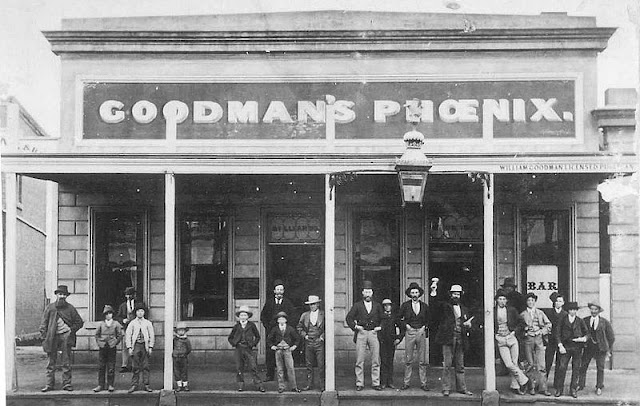 |
| The Phoenix Hotel was a hotel in Talbot, Victoria, c1870, 37 Scandinavian Crescent |
St Michaels Church of England, Talbot 1871.
St Patrick's Roman Catholic Church of Talbot 1872.
The Talbot Railway Station was built in 1875 to link the towns of Talbot and Amherst with Ballarat and Maryborough.
 |
| The Rip Van Winkle mine at Talbot, VIC, around 1875 |
1880s
 |
| Staff outside the offices of the Talbot Leader, 1880, SLVIC |
Population of Talbot in 1881 was 2318.
The Talbot Wesleyan Church held a Chinese Baptisimal Service for converts in 1881.
 |
| Lyons Commercial Hotel Building Fyfe St, Talbot. The hotel opened in 1859. It had 26 rooms, and was the stoping place for the Cobb & Co coaches. The owner of the hotel held animal sales in the street in front of the hotel once a month. The hotel closed in 1962 and the front 2 story section was demolished in 1991 |
1890s
 |
| Repairing embankment, Talbot Reservoir, VIC, Weekly Times (Melbourne, Vic. : 1869 - 1954), Saturday 12 October 1895 |
 |
| Borough hall, Talbot, VIC, Weekly Times (Melbourne, Vic. : 1869 - 1954), Saturday 12 October 1895 |
 |
| The finders of the 115oz nugget near Talbot, VIC, Weekly Times (Melbourne, Vic. : 1869 - 1954), Saturday 15 May 1897 |
1900s
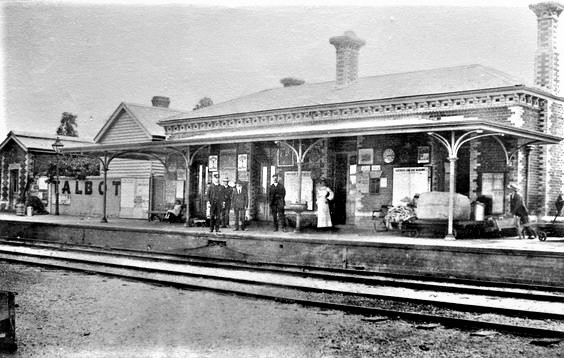 |
| Talbot Railway Station, Victoria, n.d |
 |
| August 19 1909, the night train from Ballarat was heading to Maryborough in western Victoria, when the rail bridge over McCallum's Creek, which had been weakened by flood waters, collapsed as the train crossed it. The Bridge at Dunach (between Clunes and Talbot, VIC). There were no fatalities and and only one female passenger was injured |
WWI |
| Studio portrait of 2151 Private (Pte) Harry Tarzwell Gale, 4th Reinforcements, 23rd Battalion, of Talbot, Vic. Pte Gale enlisted on 6 July 1915 and embarked from Melbourne aboard HMAT Hororata on 27 September 1915 and returned to Australia on 18 January 1919. Pte Gale previously served with the 46th Infantry, Citizens Military Force. See also DA10620. AWM |
 |
| Studio portrait of 50 Driver Robert Hall, 50th Battery, Australian Field Artillery, of Talbot, Vic. He was gassed in France and died in hospital in England on 5 July 1918, AWM |
 |
| Talbot Leader (Vic. : 1914 - 1918), Saturday 23 June 1917 |
1930s
 |
| Raising a tractor which fell through an old bridge on the Talbot to Maryborough Road, Victoria, Weekly Times (Melbourne, Vic. : 1869 - 1954), Saturday 16 August 1930 |
 |
| "A relic of the gold days - The old Bar of the Glasgow Arms Hotel now delicensed, at Talbot, Vic. ...", 1933, SLSA |
 |
| News (Adelaide, SA : 1923 - 1954), Monday 27 July 1936 |
 |
| Talbot, VIC, Weekly Times (Melbourne, Vic. : 1869 - 1954), Saturday 19 September 1936 |
1940s and WWII
"CPL, D. McKAYE FISHER, 23 and PTE, JAMES
ROLAND FISHER, 27 both reported missing are
sons of Mr and Mrs A. J. Fisher, Amherst. Pte
D. McK. Fisher, who enlisted in October 1939 was
stationed at Cobram as a Methodist home mis
sioner, and Pte J. R. Fisher, who enlisted in
November 1939 was a poultry farmer. Both lived
at Talbot"."PERSONAL NOTES ON OVERSEA CASUALTIES" The Argus (Melbourne, Vic. : 1848 - 1957) 12 June 1941
 |
| Talbot, VIC, Weekly Times (Melbourne, Vic. : 1869 - 1954), Wednesday 2 May 1945, |
 |
| Talbot Fire Brigade, VIC, Weekly Times (Melbourne, Vic. : 1869 - 1954), Wednesday 2 May 1945, |
 |
| Australian Jewish Herald (Melbourne, Vic. : 1935 - 1955), Friday 23 January 1948 |
 |
| Employees of Talbot branch of Maryborough knitting Mills, with manageress (Miss D. Kennedy), in centre, VIC. Weekly Times (Melbourne, Vic. : 1869 - 1954), Wednesday 19 October 1949 |
 |
| Camp Street, Talbot, VIC, Weekly Times (Melbourne, Vic. : 1869 - 1954), Wednesday 19 October 1949 |
 |
| Talbot, VIC, Red Cross, Weekly Times (Melbourne, Vic. : 1869 - 1954), Wednesday 19 October 1949 |
1990s
The Talbot train station closed on 12 September 1993.
Most of Talbot and Clunes shire was united with Maryborough city and most of Bet Bet and Tullaroop shires to form Central Goldfields shire, on 19 January 1995.
2000s
Victoria’s only private astronomical observatory is located at Talbot. It is open to the public and was completed in 2002.
Just 5 kilometres north-west of Talbot is the town of Amherst, first settled in 1855. However, most of Amherst's buildings, which
at one time included seven general stores, an inn and a hospital, have been destroyed by bushfires.
Around Talbot
 |
| Carnation Flour sign Talbot, VIC |
 |
| The Aboriginal Maternity Tree is a giant River Red Gum, estimated to be about 700 years old, Talbot, VIC |
 |
| Located in the bushland alongside Possum Gully Road, Amherst, about 10 minutes from Talbot, VIC. Believed to be the original site of a Chinese Joss & Bath House |
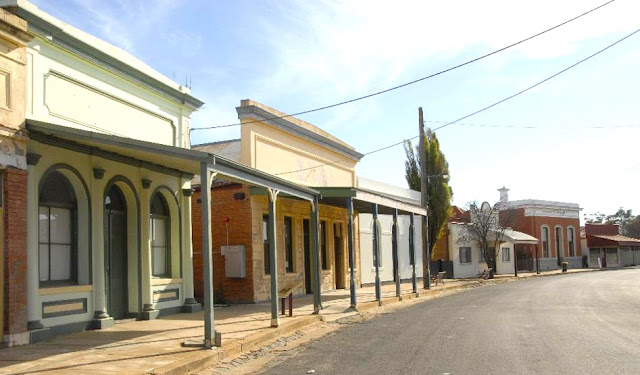 |
| Scandinavian Crescent, Talbot, VIC |
 |
| Talbot Town Hall built 1862, VIC |
 |
| The former Bull & Mouth Hotel, Talbot, VIC, built of local basalt in 1865 by William Owen. The original Bull & Mouth Hotel was opposite and was demolished to make way for Heales Street |
 |
| Court House - Camp St, Talbot, built 1861 |
 |
| The former Goodman's Phoenix hotel and Bank of Australasia, Talbot, VIC |
 |
| Lyons Commercial Hotel Building Fyffe St, VIC, built 1861. Originally Thomas Wriggley operated a hotel on this site. Patrick Lyons operated the hotel in 1861, it had 26 rooms |
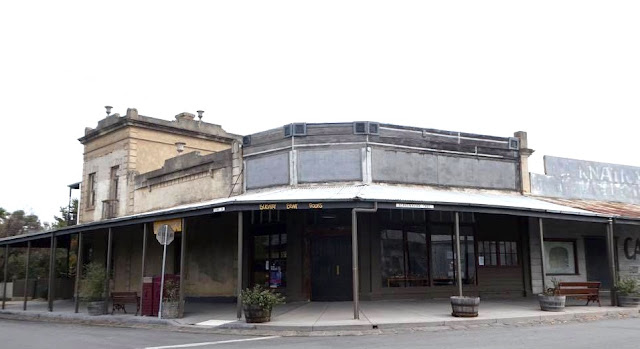 |
| Talbot, VIC |
 |
| Originally a flour mill in the 1800s, Talbot, VIC |
 |
| The Talbot Post and Telegraph Office was built between 1860 and 1877 on Camp St, Talbot, VIC |
 |
| Talbot Library, ViC |
 |
| Primitive Methodist Chapel, erected in 1870/1, Talbot, VIC |
 |
| The former London Chartered Bank at, Talbot, Victoria, Mattinbgn |
Things To Do and Places to Go
Walking tour map of Talbot available at the Talbot Arts & Historical Museum
Read
The Sink of Iniquity ( 2015), by Douglas Wilkie.























































